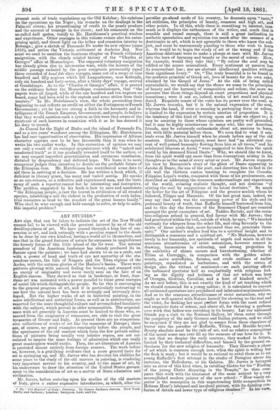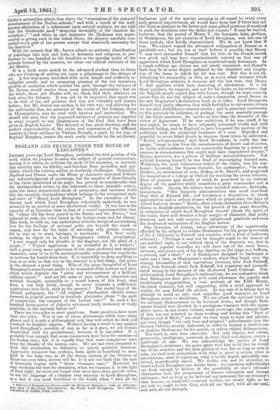ART STUDIES.*
ANY sign that can be taken to indicate the art of the New World cannot fail to be viewed with the greatest interest by us of the old dwelling-places of art. We have passed through a long line of suc- cession in art, and look naturally with a peculiar regard to the deeds to be done by our own kindred, having a world all to themselves, and one that in the grand features of nature far surpasses in magnificence the homely forms of this little island of the far west. The natural rear of the American landscape has already produced its in- endnce upon the painters; we have had shown to us on a scale, and with a power of hand and truth of eye not unworthy of the stu- pendous scenes, the falls of Niagara and the Titan regions of the Andes, with the autumn glories of the Hudson's banks. These were pictures glowing with natural feeling for beauty, and stamped with an energy of originality and verve rarely seen on the face of an English canvas. They showed us that in landscape, at least, Ame- rican art was animated with a power parallel to those great energies of social life which distinguish the people. So far this is encouraging to the general progress of art, and it is particularly instructing to see how the natural bent has been so strongly and nervously deve- loped. But the higher walks of art in historical painting, in the more intellectual and msthetical forms, as well as in architecture, are reserved for the more thoughtful culture and accomplished familiarity with the subject, which prevail in older communities. The acquaint- ance with art generally in America must be limited to those who, re- moved from the exigencies of commerce, are able to visit the great treasuries of Greece and Italy. At present there are no comprehen- sive collections of works of art like the museums of Europe; there are, of course, no good examples constantly before the people, and the specimens of the old masters which form the few private collec- tions of pictures being usually very inferior copies, are not cal- culated to inspire the same feelings of admiration which one really great masterpiece would excite. Then, the art-literature of America is provided almost entirely from foreign sources. The work before us, however, is a gratifying evidence that a more general taste for art is springing up, and Mr. Jarves who has devoted his abilities for some years to the study of the old masters in painting, is rendering very important service to his country, and to the cause of art, by his endeavours to draw the attention of the United States govern- ment to the consideration of art as a matter of State education and civilization.
Mr. Jarves, before entering upon his studies of the old masters of Italy, gives a rather expansive introduction, in which, after the The "Old Masters" of Italy : Painting. By James Jackson Jarves. New York Derby and Jackson; London: Sampson, Low; and Co. peculiar go-ahead mode of his country, he descants upon " taste," art criticism, the principles of beauty, common and high art, and other points. In all this, while there is something to interest, inns. much as it displays the enthusiasm of the writer, and much that is sensible and sound enough, there is still a great inclination to [esthetic speculation and mysticism too much after the manner of a doctrinaire in art, which is not agreeable to those who know the sub-. ject, and mast be uncommonly puzzling to those who wish to learn it. It would be to begin the study of art at the wrong end if the American dilettanti were to make a plunge at once with Mr. Jarves into the laws of harmony and beauty or the moral of colour. How, for example, would they take this : "By colour the soul may be edified or the senses sensualised. Every sentiment or passion has its concomitant hue; nor are abstract intellectual qualities without their significant livery." Or, "The truly beautiful is to be found in the testhetic principle of Greek art, love of beauty for its own sake, vitalized by the Gospel of Jesus." At the risk of being called materialistic, we would say that the closer we come to the principles of beauty and the harmony of composition and colour, the more we perceive that these things depend on exact proportions and physical sensations ; were it not so, indeed, works of art could not be pro- duced. Exquisite music of the voice has its power over the soul, as Mr. Jarves remarks, but it is the natural expression of the soul, whereas the hand, if ever so cunning in portraying form or colour, is limited to the expression by certain niceties of proportion. It is the tendency of this kind of writing upon art that we object to; it may be amusing to those whose opinions are pretty well grounded, but it may be highly mischievous to many who, like our American friends, may be extremely enthusiastic about art, anxious to learn, but with little material before them. We soon find to what it mis- leads even Mr. Jarves himself when he stands before any of the old masters. Giotto, in his opinion, must have had "an electrical cur- rent of well-poised humanity flowing from him at all times," and his celebrated frescoes at Assist "were suggested to him from the spirit world by his deceased friend Dante." Why, we should like to know, from the spirit world any more than from conceptions arising in his thoughts as in the mind of every artist or poet. Mr. Jarves supports his view by Boccaccio's story of the ghost of Dante appearing to Jacobo di Dante, the son of the poet, and, directing him to find in the old wall the thirteen cantos wanting to complete the Comedia. Filippino Lippi's works, compared with those of his predecessors, are described as addressing the common understandings and experiences of the world, evincing realistic thought, and not desirous "of stirring the soul by suggestions of its latent destinies." So much the better for the art of Filippino and the greater models whom he followed, Filippo and Masaccio. Of the last great man, indeed, we may say that such was the surpassing power of his style and its perennial beauty of truth, that Raffaelle himself borrowed from him, and to this day the frescoes of the Braneacci Chapel are counted amongst the great exemplars of art. Taddeo Bartolo, and the costa- tico-religious school in general, find favour with Mr. Jarves; they had penetrated within the veil, outside of which, he says, "We hearken curiously for whispers from the other life, and cling fervently to the skirts of those souls that, more favoured than we, penetrate there- unto." Our author's studies lead him to a spiritual insight and to distinguish a sensuous and a spiritual art. "No Madonna, however lovely in her humanity, nor spectacle of angels and saints in all the sensuous attractiveness of strict naturalism, however correct in drawing, harmonious in colouring, and strong projection by the subtleties of chiaro oscuro and foreshortening, whether of Titian or Correggio, in comparison with the golden adorn- ments, naive accessories, flatness, and crude outlines of earlier paintings, repudiated as barbarisms, and with the errors of design also the virtues of sentiment—no such painting affects the unbiassed spectator half so emphatically with religious feel- ing as the dignity mid holiness of that art which was born of Orcag,na, Giottino, Cavallini, and a host of kindred minds." As we said before, this is not exactly the kind of art teaching which we should commend for a young nation; it is calculated to convert all unbiassed spectators into prejttdieed and infatuated sentimentalists. And as to the sensuous attractiveness of strict naturalism, why we might as well quarrel with Nature herself for showing us the rose and the violet, for decking her most perfect forms with the most refined and exquisite tints of colour, and above all, for throwing a perfume over work that before was ravishing in its beauty. Let our unbiassed friends pay a visit to the National Gallery, let them enter through the purgatory of the early German and Italian pictures, and we shall be surprised if they are not glad to escape from these chambers of horror into the paradise of •Raffaelle, Titian, and Murillo beyond. Beauty absolute must be the rule of art, and no relative conceptions of the moral sense can ever fill up the measure of our love for it. It is not that we despise the early masters; they worked in fetters, limited by their technical difficulties, and biassed by the general en- thusiasm for the new religion of humanity. They illustrate a phase of art which is common enough now, when the spirit is willing but the flesh is weak; but it would be as rational to extol them as to set young Raffaelle's first attempt in the studio of Perugia° above his cartoons, the Heliodorus, or his Galatea. Mr. Jarves is betrayed into an error of this kind when, in extolling Giotto for his "Finding of the young Christ disputing in the Temple," he thus com- pares that work with the treatment of the same subject by a very accomplished modern painter of the new school : "How vastly su- perior is the conception in this unpretending little composition to Holman Hunt's laboured and involved picture, with its dazzling con- fusion of details and lower type of religious idealism!" In his view, Giotto's naturalism places him above the "sensualism of the matured development of the Italian schools," and with a touch of the well- known affectation of a refinement upon natural modesty, we are told that the Giotteschi used "draperies invariably of the chastest de- scription ;" "and when in rare instances the Madonna was repre- sented as giving suck to the infant Jesus, the drapery carefully con- cealed every part of her person except that absolutely necessary for the function.'
With the remark that Mr. Jarves adopts an esthetic classification of paintings into epic and lyric, or dramatic and religious, in pre- ference to one founded on the localities or the peculiar styles of the schools formed by the masters, we close our critical estimate of his Art Studies.
It is a book more suited to the advanced student than to those who are thinking of setting out upon a pilgrimage to the shrines of art. A few way-posts inscribed with more simple and evidently in- telligible words, and an unsparing pruning of the too luxurious growth of esthetics which cumber the path through the volumes of Mr. Jarves, would render them more generally acceptable ;- but on the whale, these Art Studies will, we think, find their admirers on both sides the Atlantic. It was not to be expected that much was to be told of the old painters that was not tolerably well known before ; but Mr. Jarves has spoken in his own way, and allowing for his spiritualist bias, his accounts of the works of the Italians, down to Domenichino, may be read with interest and instruction. We should add also, that the engraved outlines of pictures are superior in every respect to any illustrations of the kind that have been given in English books. The delicacy of line, good drawing, and the perfect representation of the styles and expression of the different masters in these outlines by Vicenzo Stanglii, a pupil, by the way, of Raphael Morghen, render the work really valuable to the art-library.































 Previous page
Previous page